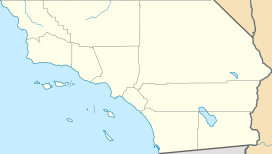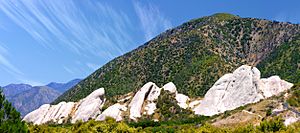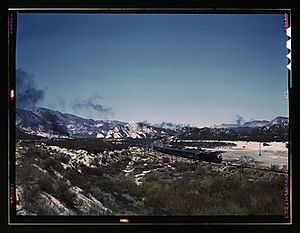Cajon Pass facts for kids
Quick facts for kids Cajon Pass |
|
|---|---|
| Spanish: Puerto del Cajón, Paso del Cajón | |
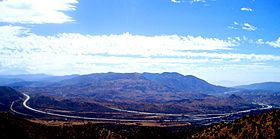
I-15 passing over Cajon Summit
|
|
| Elevation | 3,777 ft (1,151 m) |
| Traversed by | Union Pacific Railroad/BNSF Railway/Amtrak |
| Location | San Bernardino County, California, United States |
| Range | San Bernardino Mountains/San Gabriel Mountains |
| Coordinates | 34°19′33″N 117°25′42″W / 34.32583°N 117.42833°W |
The Cajon Pass (pronounced Cah-hone) is a special mountain pass in Southern California. It sits between the San Bernardino Mountains on one side and the San Gabriel Mountains on the other. In Spanish, its name means Puerto del Cajón or Paso del Cajón, which translates to "Box Canyon Pass" or "Drawer Pass."
This pass was formed by the powerful movements of the San Andreas Fault. It is about 3,777 ft (1,151 m) high. The Cajon Pass is in the Mojave Desert. It's a really important pathway. It connects the San Bernardino Valley to the Victor Valley and goes all the way northeast to Las Vegas.
The Cajon Pass is located at the start of Horsethief Canyon. California State Route 138 (SR 138) goes through it, as do railroad tracks. These tracks are owned by BNSF Railway and Union Pacific Railroad. While Interstate 15 doesn't go directly through the Cajon Pass, it crosses a nearby spot called Cajon Summit. This summit is a bit higher, at 4,260 feet (1,300 m). People often call the whole area "Cajon Pass," but there is a difference between the pass and the summit.
In 1851, a group of Mormon settlers traveled through Cajon Pass. They were led by Amasa M. Lyman and Charles C. Rich. They used covered wagons on their journey from Salt Lake City to southern California. A famous rock formation in the pass is called Mormon Rocks. It's where the old Mormon Road and the railway meet.
Contents
Pacific Crest Trail Adventures
The famous Pacific Crest Trail goes right through Cajon Pass. During hiking season, many hikers pass through this area. They often arrive after walking one of the hottest and driest parts of the trail.
There's a McDonald's restaurant very close to the trail. It's well-known among hikers. They often stop there for water and salty food. Many hikers also stay overnight at the one motel in Cajon Pass.
Natural Challenges in Cajon Pass
Cajon Pass can face several natural challenges. These include wildfires, strong winds, and even snow.
Wildfires
Wildfires have caused problems near the pass many times. In 2003, large fires forced Interstate 15 to close. After the fires, heavy rains caused landslides, closing the freeway again.
In 2015, a fast wildfire swept over Interstate 15. It happened during a severe drought. Drivers had to run for safety, and 20 vehicles caught fire. The freeway was closed for a time.
The Blue Cut Fire in 2016 also closed the freeway for days. This fire was very intense. It destroyed homes and businesses, including the Summit Inn Restaurant. A McDonald's was also damaged.
Wind Hazards
Cajon Pass is also known for its strong winds. The Santa Ana winds often blow through this area. These winds can be very powerful, sometimes reaching gale-force strength.
Because of the winds, there are often high wind warnings. Road signs are posted to warn drivers. It's not unusual to see large trucks overturned during windy weather.
Snow and Ice
Sometimes, Cajon Pass gets snow. There can be enough snow to close the pass temporarily. When it snows, the California Highway Patrol sets up checkpoints.
Most southern Californians don't have snow tires or snow chains. So, they have to turn back or wait until the snow is cleared. When there's snow or strong wind, TV reporters often do live reports from Cajon Pass.
The San Andreas Fault runs through Cajon Pass. This fault is responsible for the unique mountains and valleys in the area.
Rail Transport Through the Pass
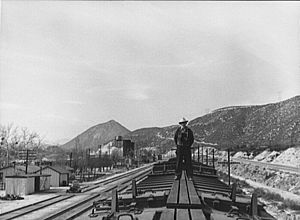
Train Traffic
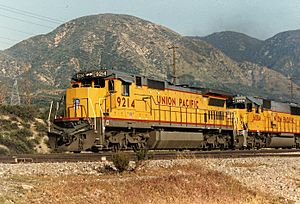
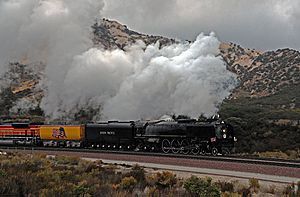
The California Southern Railroad was the first railway through Cajon Pass. It was built in the 1880s. This line connected Barstow and San Diego. Today, the Union Pacific Railroad and BNSF Railway use the pass. They connect to Los Angeles and San Bernardino.
Cajon Pass is a very popular spot for railfans. This is because many trains pass through, the scenery is beautiful, and it's easy to access. You can find many photos of trains here in books and magazines.
The Union Pacific Railroad has one track through the pass. The BNSF Railway has two tracks and added a third in 2008. The railroads share their tracks. The steepness of the tracks can be challenging for long trains. Trains usually go up the pass at 14 to 22 mph (23 to 35 km/h). They go down at 20 to 30 mph (32 to 48 km/h). With three tracks, the BNSF lines can handle up to 150 trains each day.
Train Incidents
Sometimes, accidents happen on the tracks.
- In 1989, a train accident happened south of the pass.
- In 1994, a Santa Fe train crashed into a Union Pacific train. The crews were warned and got out of the trains safely.
- In 1996, a Santa Fe train derailed and caught fire.
- The Blue Cut Fire in 2016 destroyed a trestle bridge on the Union Pacific line.
- In 2018, a train carrying special materials derailed. This caused a nearby FedEx building and a school to evacuate.
Passenger Train Service
Amtrak's Southwest Chief train still runs daily through Cajon Pass. It travels between Chicago and Los Angeles on the BNSF line.
In 2020, a company called Brightline began planning for a high-speed train route. This route would connect Victorville and Rancho Cucamonga. It would be an extension of their Brightline West service.
See also
 In Spanish: Puerto del Cajón para niños
In Spanish: Puerto del Cajón para niños


